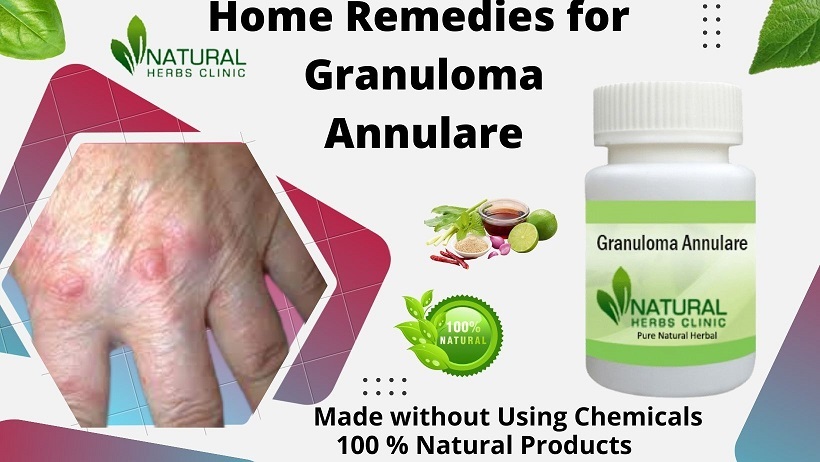
Herbal Supplements for Granuloma Annulare
Granuloma annulare (GA) is a skin condition that causes raised, red or skin-colored rings or bumps on the skin. Though generally harmless, granuloma annulare can be frustrating for those who seek clear skin. This condition is commonly found on hands, feet, elbows, and knees, and while its exact cause is unknown, factors such as minor skin injuries, certain medications, and other health conditions are suspected triggers.
Natural ways to manage granuloma annulare, with steps to improve skin health and minimize flare-ups through holistic and supportive remedies. If you’re looking for a gentle, natural approach, here are simple, effective steps to help you achieve clearer skin.
Granuloma Annulare: Symptoms and Triggers
To treat granuloma annulare naturally, it’s essential to understand the condition. Granuloma annulare presents as circular or ring-like clusters of small, firm bumps on the skin, and may be either red or skin-colored. Although generally not itchy or painful, these bumps may persist for months or even years.
Potential triggers include:
- Skin injuries: Small cuts, abrasions, and insect bites.
- Medications: Some drugs, especially anti-hypertensives, have been associated with GA.
- Health conditions: People with diabetes and thyroid disease may experience GA more frequently.
- Stress and lifestyle factors: High stress levels can exacerbate skin conditions, including GA.
Being aware of these triggers and managing them can often reduce flare-ups naturally.
Adopt Anti-Inflammatory Foods
The connection between diet and skin health is undeniable. Eating foods with anti-inflammatory properties can help alleviate granuloma annulare symptoms and prevent new lesions. Foods that fight inflammation include:
- Leafy greens: Spinach, kale, and arugula are packed with vitamins A, C, and K, which reduce inflammation.
- Berries: Blueberries, strawberries, and blackberries contain antioxidants that help in skin repair.
- Fatty fish: Salmon, mackerel, and sardines are rich in omega-3 fatty acids, which have anti-inflammatory properties.
- Nuts and seeds: Almonds, chia seeds, and flaxseeds contain beneficial fats and minerals for skin health.
- Green tea: This beverage is packed with polyphenols, which protect against skin damage.
By incorporating these foods into your daily diet, you support your body’s natural defenses and reduce inflammation associated with granuloma annulare.
Topical Natural Remedies for Skin Health
There are several natural remedies that may help reduce the appearance of granuloma annulare lesions and improve overall skin health. These remedies can be applied directly to the skin to soothe irritation and promote healing.
a) Aloe Vera
Aloe vera has cooling and anti-inflammatory effects, making it ideal for soothing skin conditions. Apply pure aloe vera gel directly to affected areas daily to reduce redness and swelling.
b) Apple Cider Vinegar
Apple cider vinegar has antibacterial and anti-inflammatory properties. Dilute one part apple cider vinegar with three parts water, soak a cotton pad in the solution, and apply it to the affected areas. Avoid applying undiluted vinegar, as it may irritate sensitive skin.
c) Tea Tree Oil
Known for its antimicrobial and anti-inflammatory properties, tea tree oil can be diluted with a carrier oil (such as coconut oil) and applied to the skin. Apply it gently to granuloma annulare lesions to help reduce inflammation.
d) Turmeric Paste
Turmeric is a powerful anti-inflammatory agent. Mix turmeric powder with water to create a paste, apply it to the affected areas, and rinse off after 20 minutes. Alternatively, turmeric can be consumed with food to help reduce inflammation internally.
Herbal Treatments to Reduce Granuloma Annulare Symptoms
Herbs have been used for centuries to manage skin conditions. Some Best Treatment for Granuloma Annulare may reduce the inflammation and skin irritation associated with granuloma annulare. Here are a few to consider:
- Calendula: Calendula is renowned for its skin-soothing properties. Calendula-infused creams or oils can be applied to granuloma annulare patches to promote healing.
- Chamomile: Chamomile, with its calming and anti-inflammatory effects, can be applied topically or consumed as tea. Use chamomile tea bags as compresses on the skin.
- Licorice root: Licorice root contains glycyrrhizin, which has been shown to reduce inflammation. Apply licorice root extract topically or consume licorice tea.
- Gotu kola: Known for its wound-healing properties, gotu kola may help reduce granuloma annulare lesions. Gotu kola cream can be applied to the skin, or you can take it as a supplement.
For best results, perform a patch test with any new topical remedy to ensure it doesn’t irritate your skin.
Boost Your Immune System
Since skin health is closely tied to immunity, a strong immune system can help your body manage granuloma annulare more effectively. Here are natural ways to boost your immune health:
- Sleep well: Aim for 7-8 hours of restful sleep to allow your body to repair and strengthen.
- Exercise regularly: Physical activity helps reduce stress and improves circulation, which promotes skin health.
- Reduce stress: Stress can exacerbate skin conditions. Consider relaxation techniques such as yoga, meditation, or deep breathing exercises to keep stress levels in check.
- Take supplements: Vitamins C, D, and zinc are vital for immune health. Consult with a healthcare provider before adding any new Supplements for Granuloma Annulare to your regimen.
Apply Moisturizers Regularly
Keeping your skin hydrated can help reduce dryness and irritation associated with granuloma annulare. Choose moisturizers that are gentle, free from fragrances, and rich in natural ingredients like shea butter, jojoba oil, and avocado oil. Applying a moisturizer right after bathing can help lock in moisture, soothing the skin and promoting healing.
Consider Sun Protection
Protecting your skin from the sun is essential, as sun exposure can worsen skin conditions. Using a broad-spectrum, mineral-based sunscreen with at least SPF 30 can protect the skin while minimizing flare-ups. Zinc oxide and titanium dioxide-based sunscreens are recommended for sensitive skin, as they are less likely to cause irritation.
Manage Blood Sugar Levels
Some studies have linked granuloma annulare to diabetes, suggesting that people with diabetes or insulin resistance may be more likely to experience this skin condition. Maintaining balanced blood sugar levels can therefore play a role in reducing the severity of granuloma annulare.
Here are some tips for healthy blood sugar management:
- Limit sugar and refined carbohydrates: Reduce intake of sugary foods and drinks, white bread, and processed snacks.
- Eat fiber-rich foods: Fiber can help slow the absorption of sugar, keeping blood sugar levels stable.
- Avoid skipping meals: Eating balanced meals at regular intervals prevents blood sugar spikes.
If you have diabetes, work closely with your healthcare provider to develop a personalized plan.
Stay Hydrated
Proper hydration is essential for skin health. Drinking enough water supports your body’s natural detoxification process, which can benefit the skin and overall health. Aim for at least 8 glasses of water daily and consider incorporating hydrating foods like cucumbers, watermelon, and citrus fruits.
Track Your Triggers and Symptoms
Keeping a journal can help you identify and manage triggers for granuloma annulare. Note what you eat, activities, stress levels, and any skincare products you use. Tracking symptoms alongside these factors can provide valuable insights, allowing you to make lifestyle changes that reduce flare-ups over time.
In Summary
Granuloma annulare can be challenging, but a holistic, natural approach can support clear skin and minimize discomfort. By focusing on anti-inflammatory foods, natural remedies, immune health, hydration, and lifestyle adjustments, you can manage granuloma annulare symptoms effectively.
Remember to consult with a healthcare provider before trying new supplements or herbal treatments to ensure they align with your health needs. With patience and consistency, these natural steps can help improve your skin’s appearance, bringing you closer to the clear, healthy skin you desire.







